2007 VOLKSWAGEN BEETLE ESP
[x] Cancel search: ESPPage 85 of 138
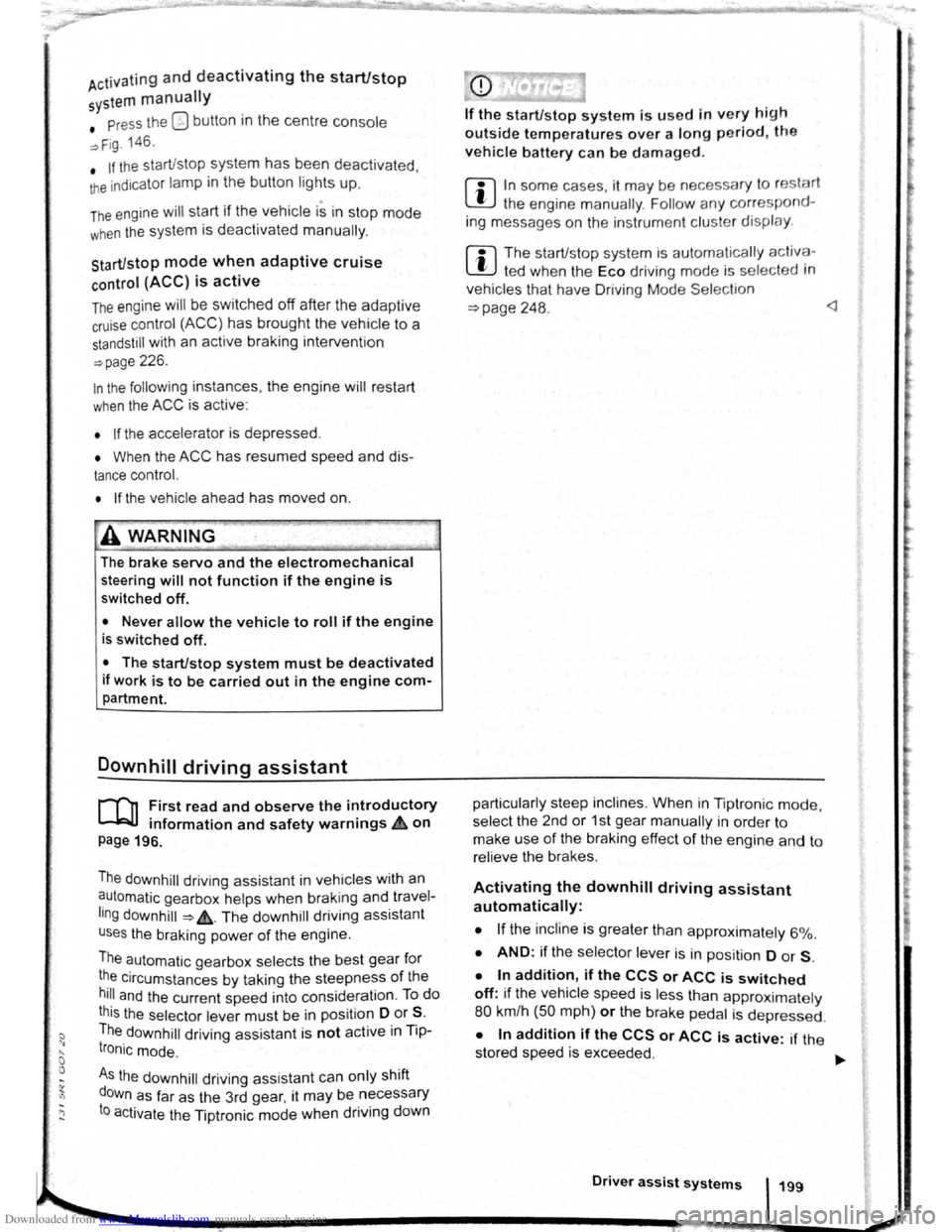
Downloaded from www.Manualslib.com manuals search engine Activating and deactivating the start/stop
system manually
• Press the 0 button in the centre console
~Fig. 146.
• If the start/stop system has been deactivated,
the indicator lam p in the button lights up.
The engine will start if the vehicle is in stop mode
when the system is deactivated manually.
Start/stop
mode when adaptive cruise
control (ACC) is active
The engine will be switched off after the adaptive
cruise control (ACC) has brought the vehicle to a
standstill with an active braking intervention
~page 226.
In the following instances, the engine will restart
when the ACC is active:
• If the accelerator is depressed.
• When the ACC has resumed speed and dis
tance control.
• If the vehicle ahead has moved on.
The brake servo and the electromechanical
steering will not function if the engine is
switched off.
• Never allow the vehicle to roll if the engine
is switched off.
• The start/stop system must be deactivated
if work is to be carried out in the engine com
partment.
Downhill driving assistant
rf'n First read and observe the introductory
~ information and safety warnings £ on
page 196.
The downhill driving assistant in veh icles with an
~utomatic gearbox helps when braking and travel
ling downhill ~ £. The downhill driving assistant
uses the braking power of the engine .
The automatic gearbox selects the best gear for
t~e circums tances by taking the steepness of the
h1l.l and the current speed into consideration. To do
th1s the selector lever must be in position D or S.
The downhill driving assistant is not active in Tip
Ironic mode .
As the downhill driving assistant can only shift
down as far as the 3rd gear, it may be necessary
to activate the Tiptronic mode when driving down
If the start/stop system is used in very high
outside temperatures over a long period, the
vehicle battery can be damaged.
m In some cases, it may be necessa ry to restart
L!J the engine manually. F ollow any correspond
ing messag es on the instrument cluste r display.
m The start/stop system is automatically activa
L!J ted when the Eco driving mode is selected in
vehicles that have Driving Mode Selection
~page 248 .
select the 2nd or 1st gear manually in order to
make use of the braking effect of the engine and to
relieve the brakes .
Activating the downhill driving assistant
automatically:
• If the incline is greater than approximately 6%.
• AND: if the selector lever is in position 0 or s.
• In addition, if the CCS or ACC is switched
off: if the vehicle speed is less than approximately
80 km/h (50 mph) or the brake pedal is depressed.
• In addition if the CCS or ACC is active: if the
stored speed is exceeded .
Driver
assist systems 199
..
Page 87 of 138
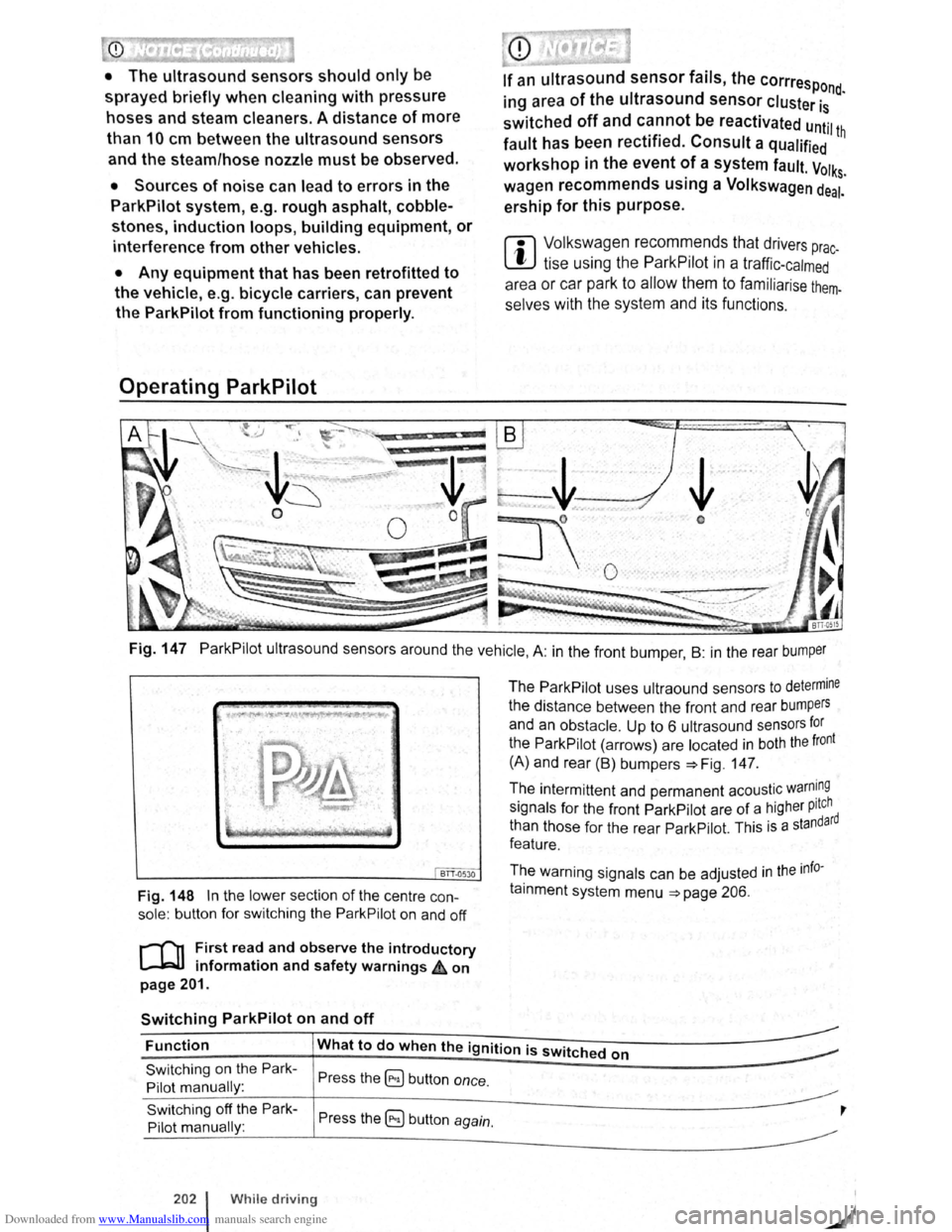
Downloaded from www.Manualslib.com manuals search engine CD
• The ultrasound sensors should only be
sprayed briefly when cleaning with pressure
hoses and steam cleaners. A distance
of more
than
10 cm between the ultrasound sensors
and the steam/hose nozzle must
be observed.
• Sources of noise can lead to errors in the
ParkPilot system, e.g. rough asphalt, cobble
stones, induction loops, building equipment,
or
interference from other vehicles.
• Any equipment that has been retrofitted to
the vehicle, e.g . bicycle carriers, can prevent
the ParkPilot from functioning properly.
Operating ParkPilot
If an ultrasound sensor fails, the corrrespond.
ing area of the ultrasound sensor cluster is
switched off and cannot be reactivated until th
fault has been rectified. Consult a qualified
workshop in the event
of a system fault. Volks.
wagen recommends using a Volkswagen deal.
ership for this purpose .
r::l Volkswagen recommends that drivers prac
L!J tise using the ParkPilot in a traffic-calmed
area or car park to allow them to familiarise them
selves with the system and its functions.
Fig. 147 ParkPilot ultrasound sensors around the vehicle, A: in the front bumper , B : in the rear bumper
BTT.Q530
Fig. 148 In the lower section of the centre con
sole: button for switching the ParkPilot on and off
r-('n First read and observe the introductory
l.-JRlJ information and safety warnings ,£ on
page 201.
Switching ParkPilot on and off
The ParkPilot uses ultraound sensors to determine
the distance between the front and rear bumpers
and an obstacle. Up to 6 ultrasound sensors for
the ParkPilot (arrows) are located in both the front
(A) and rear (B) bumpers :::.Fig. 147.
The intermittent and permanent acoustic
warn~ng
signals for the front ParkPilot are of a higher pitch d
than those for the rear ParkPilot. This
is a standar
feature.
The warning signals can be adjusted
in the info
tainment system menu :::.page 206.
Function What to do when the ignition is switched on
Switching on the Park
Pilot manually :
Switching off the Park
Pilot manually :
202 l While driving
Press the ~ button once.
Press the 5) button again.
,
Page 100 of 138
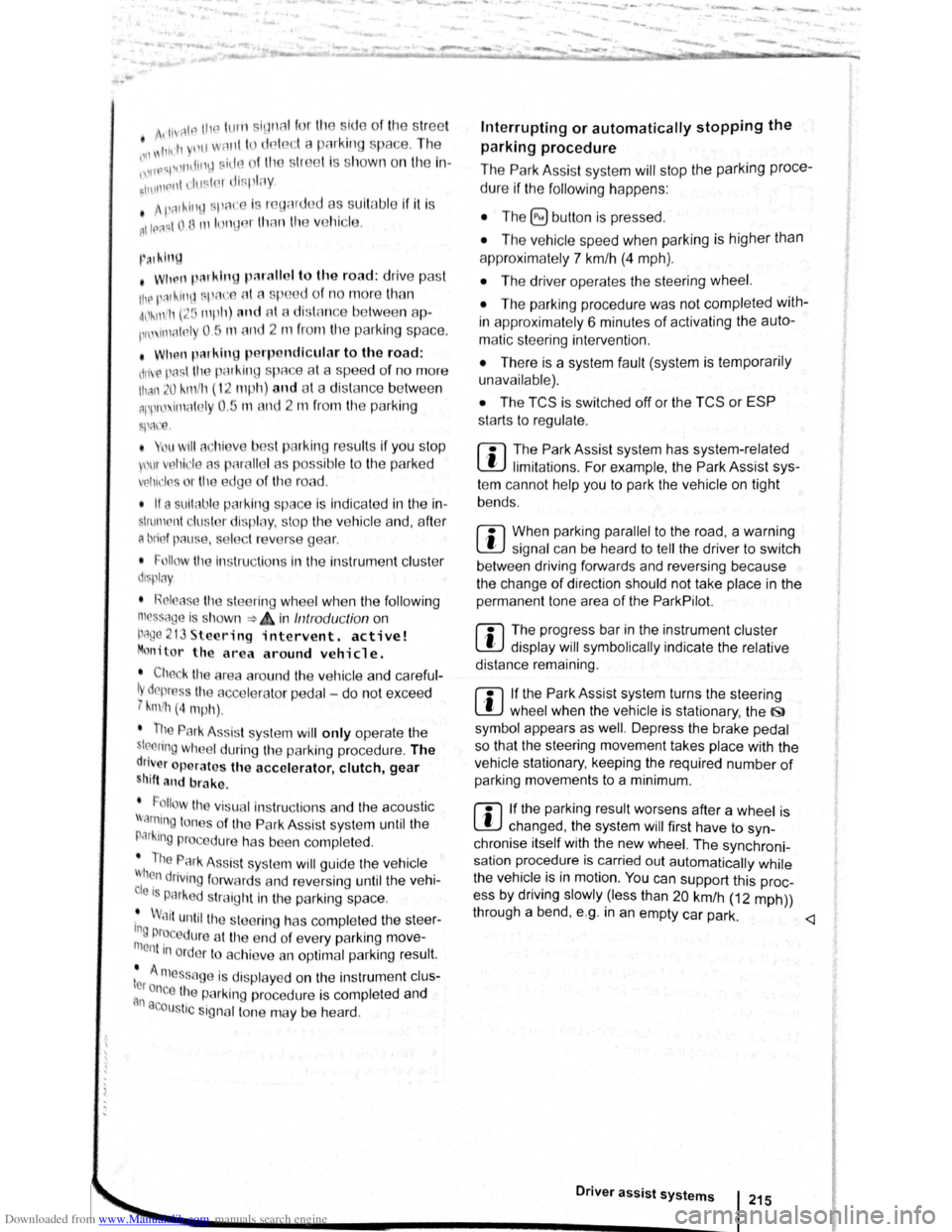
Downloaded from www.Manualslib.com manuals search engine ' '' '
-
,li ~lP lllP lUll' slynr~l for tl1e s.ide o f th e s tree t
11 1, ,,u v ;:~r1l t
o l P lP ·t a pllrk111g space . Th e ,,, ,, 11 ' ' ~1,, ruli11\.l ~ide f the lr ells sl1own o n the tn-
'''"P , ~\111111P11 l itlq{(ll displlly
I p8d,ir1\-J ~pc:n·e i s t gmdod as suit ab le i f it is
:IIPR~l o a 11, lo11u o r lllall llle ve hi cle.
1'~1 "'" • WIIPil 1 AI kin g prtrall el to the road: driv e pas t
thE~ pe~'"'''~ Rp;:~ce Rl a SI ee d of no m ore than
~~ ~rll'h ( r. rnpll) and at a d is ta n ce betw een ap
pr\.l\llllRlr l Q .r. Ill cmd 2 rn from the parking sp ace .
, Wlum p~r kin perpendicular to the road:
dn\ e pns tllle p;:1rl~i11 space a t a sp ee d of n o mor e
lhan :£0 ""'11' (1 2 111~h) and a t a dista nce be tw ee n
ili'P' \ltmle ly 0.5 m a nd 2 m from the parking
~I'R '9 .
• Yuu \1 ill R ·lli eve b st parkin g result s if yo u stop
, ur el11 ·le a para lle l as possib le to the parke d
veh1 ·I o r tll o edge of til e road.
• If a ullal>l e par king space is indi cated in the in-
l1lll11e llt ·lust r disp la y, s lop the ve hicle and , after
a brief pause, se lect rev erse gear.
• F 11 w til e Ins tructions in the instrum ent cluster
dtSIJI~y
• Rei :la e til e steeri ng wheel wh en th e following
me· age Is sh ow n ~ in Introduc tio n on
Page21 teering intervent. active!
Monitor the area around vehicle.
• Clle k the area aro und the ve hi cle and careful-
1 depress til e acce lerator p e dal - do not exceed
7 hm/11 (4 nliJh).
• The Park Ass is t sys te m will only operate the
steenng wheel duri ng the parki ng pro ced ure. The
driver operates the accelerator, clutch, gear
hift and bra ke .
• r=ollow the vis ual in stru ctions and the acoustic
Wan~ing to nes of the Park As sis t system until the
Palkll1g procedur e has bee n completed .
• lhe Park Assis t sys te m will guide the vehicle
\Vhen d rivin g fo rw ards and re ve rsing until the vehi
cle Is parked straig ht in the parking space.
t Wait until the stee ring has completed the steer
ng P1~C dure at the e nd of eve ry parking move
nlent In orde r to ac hieve an optimal p arking result.
; )
A n1es age is display ed on the instrument clus
Ger one the parking procedure is completed and
n ~cou tic s ignal tone may b e he ard .
... .__ -.. -r ---.J'-
Interrupting or automatically stopping the
parking procedure
The Park Ass is t system will stop the parking proce
dure if th e following happens :
• The 8 button is pressed.
• The ve hi cle spee d when parking is higher than
app roxim ate ly
7 km /h (4 mph).
• The driver operates the steering wheel.
• The parking procedure was not completed with
in approximately 6 minutes of activating the auto
matic stee ring intervention .
• There is a system fault (system is temporarily
un ava ilable) .
•
The TCS is switched off or the TCS or ESP
starts to regulate .
r::l The Park Assist system has system-related
l!J limitations . For example, the Park Assist sys
t e m cannot help you to park the
vehicle on tight
b e nd s.
r::l Wh en parking parallel to the road , a warning
L!J signal can be heard to tell the driver to switch
between driving forwards and reversing because
the change
of direct ion should not take place in the
permanent tone area
of the ParkPilot.
r::l The progress bar in the instrument cluster
l!J display will symbolically indicate the relative
distance remaining .
W If the Park Assist system turns the steering
l!J wheel when the vehicle is stationary , the 6l
symbol appears as well. Depress the brake pedal
so that the steering movement takes place with the
vehicle stationary, keeping the required number of
parking movements to a minimum.
r::l If the parking result worsens after a wheel is
~ changed, the system will first have to syn
chronise
itself with the new wheel. The synchroni
sation procedure is carried out
automatically while
the vehicle is in motion. You can support this proc
ess by driving slowly (less than 20 km/h (12 mph))
through a bend, e.g. in an empty car park.
Page 101 of 138
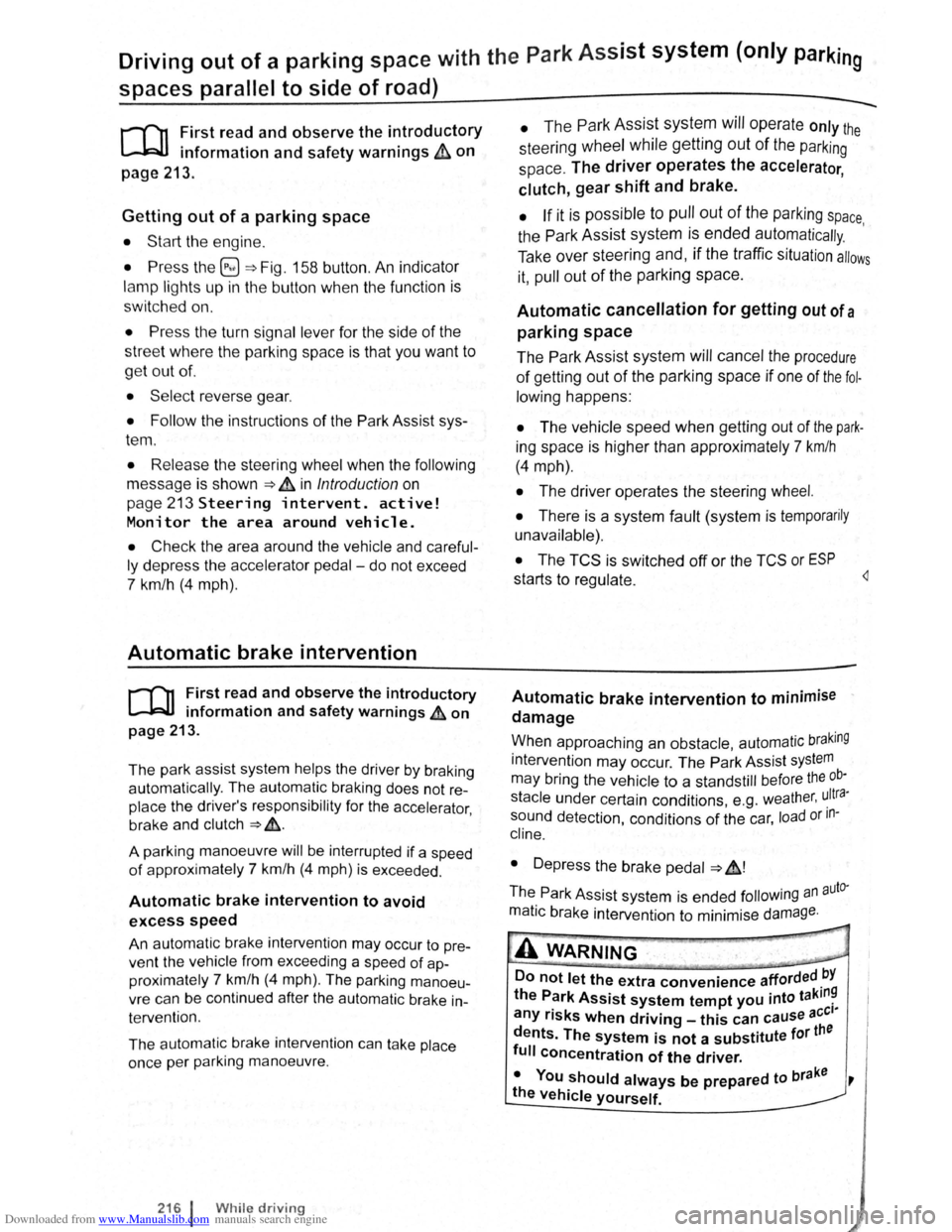
Downloaded from www.Manualslib.com manuals search engine Driving out of a parking space with the Park Assist system (only parking
spaces
parallel to side of road)
..-T'n First read and observe the introductory
L-1:J.I information and safety warnings & on
page
213.
Getting out of a parking space
• Sta rt th e e ngin e.
• Pr es s the~~ Fig . 158 button . An indicator
lamp lights up in the button when the function is
switch ed on .
• Press the turn sign al lever for the side of the
str ee t wh ere the parking space is that you want to
g e t
out of.
• Sele ct re verse gear.
• Follow the instructions of the Park Assist sys
tem .
• Release the steer ing wheel when the following
mess age is shown ~ ~ in Introdu ction on
page 213
Steering intervent. active!
Monitor the area around vehicle.
• Check the area around the vehicle and careful
ly depress the accelerator pedal -do not exceed
7 km /h (4 mph) .
Automatic brake intervention
r-('n :irst rea~ and observe the introductory
L-lc:JJ 1nformat1on and safety warnings ~ on
page
213.
The park assist system helps the driver by braking
automatically . The automatic braking does not re
place the driver's responsibility for the accelerator
brake and
clutch ~ £. '
A parking manoeuvre will be interrupted if a speed
of approximately 7 km /h (4 mph) is exceeded .
Automatic brake intervention to avoid
excess speed
An automatic brake intervention may occur to pre
vent .the
vehicle from exceeding a speed of ap
proximately 7 km/h (4 mph) . The parking manoeu
vre can be cont inued after the automatic brake in
t e rvention .
The automatic br a
ke intervention can take place
once per parking manoeuvre .
216 I While driving
---• The Park Assi~t syste.m will operate only the
steering wheel whrle gettrng out of the parking
space .
The driver operates the accelerator
. ' clutch, gear shaft and brake.
• If it is possible to pull out of the parking space
the Park Assist
system is ended automatically . '
Take
over steering and, if the traffic situation allows
it, pull out of the parking space.
Automatic cancellation for getting out of a
parking space
The Park Assist system will cancel the procedure
of getting out of the parking space if one of the fo l
lowing happens :
• The vehicle speed when getting out of the park
ing space is higher than approximately 7 km/h
(4 mph).
• The driver operates the steering wheel.
•
There is a system fault (system is temporarily
unavailable).
• The TCS is switched off or the TCS or ESP
starts to regulate . ~
Automatic brake intervention to minimise
damage
~hen approaching an obstacle, automatic braking
Intervention may occur. The Park Assist system
may bring the vehicle to a standstill before the ob
stacle under certain conditions , e .g . weather, ultra
sound detection , conditions of the car, load or in
cline .
•
Depress the brake pedal ~ &!
The. Park Assist system is ended following an auto
matic brake intervention to minimise damage.
A WARNING
Do not let the extra convenience afforded bY
the P~rk Assist system tempt you into takin~
any nsks when driving -this can cause accl
dents. The system is not a substitute tor the
full concentration of the driver.
• You should always be prepared to brake ,
the
vehicle yourself.
Page 106 of 138
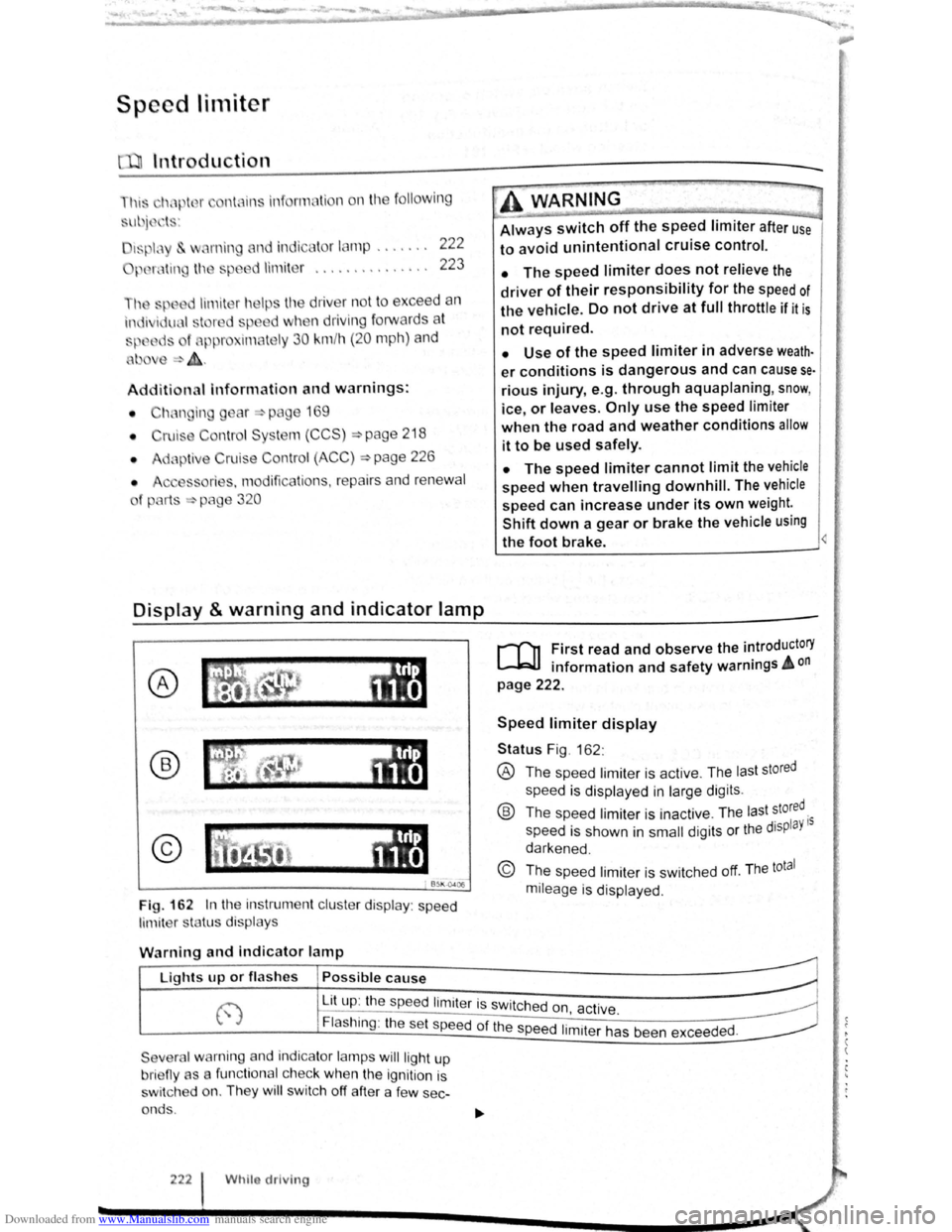
Downloaded from www.Manualslib.com manuals search engine Speed lirniter
~~~~n~t~ro~d~t~tc~t~io~r~,-----------------------------------------------
hi , h:.1~t r ntains inf nn3tion on th e fo llo wing
subjt 't ~:
lmd indi 1t r I mp . . . . . . . 222
d
limit er . . . . . . . . . . . . . . . 223
h s~ d limit r hel~ t11e driv er n ot to excee d an
individua l ~t r d ~ d wh en driving forwards at
~ t ds f 3~pr im ate ly 30 km /h (20 m ph) and
~1b -
Addition3l Information and w arnings:
• IKm in g g r page 169
• ruls Co ntro l Syst em (CCS) ==-page 218
• dnptive Cruise Con trol (ACC ) ~page 226
• Ac -s ri s, m odifications , re pairs and re newa l
f parts ~ pRge 320
Display & warning and indicator lamp
®
©
' B~K Oot06
Fig. 162 In th e instrument clu ste r display : speed
limit er sta tus disp lays
·~ ~ ' -
~~~_W_A_R_N_IN_G ________ ~~----~
Always switch off the speed limiter after use
to avoid unintentional cruise control.
• The speed limiter does not relieve the
driver of their responsibility for the speed of
the vehicle. Do not drive at full throttle if it is
not required.
• Use of the speed limiter in adverse weath·
er conditions is dangerous and can cause se
rious injury, e.g. through aquaplaning, snow,
ice, or leaves. Only use the speed limiter
when the road and weather conditions allow
it to be used safely.
• The speed limiter cannot limit the vehicle
speed when travelling downhill. The vehicle
speed can increase under its own weight.
Shift down a gear or brake the vehicle using
the foot brake.
r-f'n First read and observe the introductory
L-JcJ.I information and safety warnings A on
page 222.
Speed limiter display
Status Fig . 162 :
® The spee d limiter is active . The las t stored
speed is displayed in large dig its .
® Th e speed limiter is ina ctive . Th e last stored.
speed is shown in
small digits or the displaY 15
darkened .
© The speed limiter is sw itched off. The total
mileage is displayed .
W
arning and indicator lamp
r~~~fucl,~~~~~---------------------~ Lights up or fl as hes Possible cause
j-~~----~~==~==~~---------------~ ~ L_it;u~p~:~th~e~sp~e:e:d~l:im:i:te:r~is~sw~itc~h~e~d~o~n~~~·~~---------------~ t.,.; :1 , ac 1ve. ~
Flashing : the set speed of the speed 1. .
t h d d
Severa l warning and indicator lamps will ligh t up
bri eny as a func tiona l c h ec k
when the ignition is
s wi tc h ed on. They
wi ll swi tc h off after a few sec
onds .
222 Whilo driving
1m1 er as been excee e .
Page 115 of 138
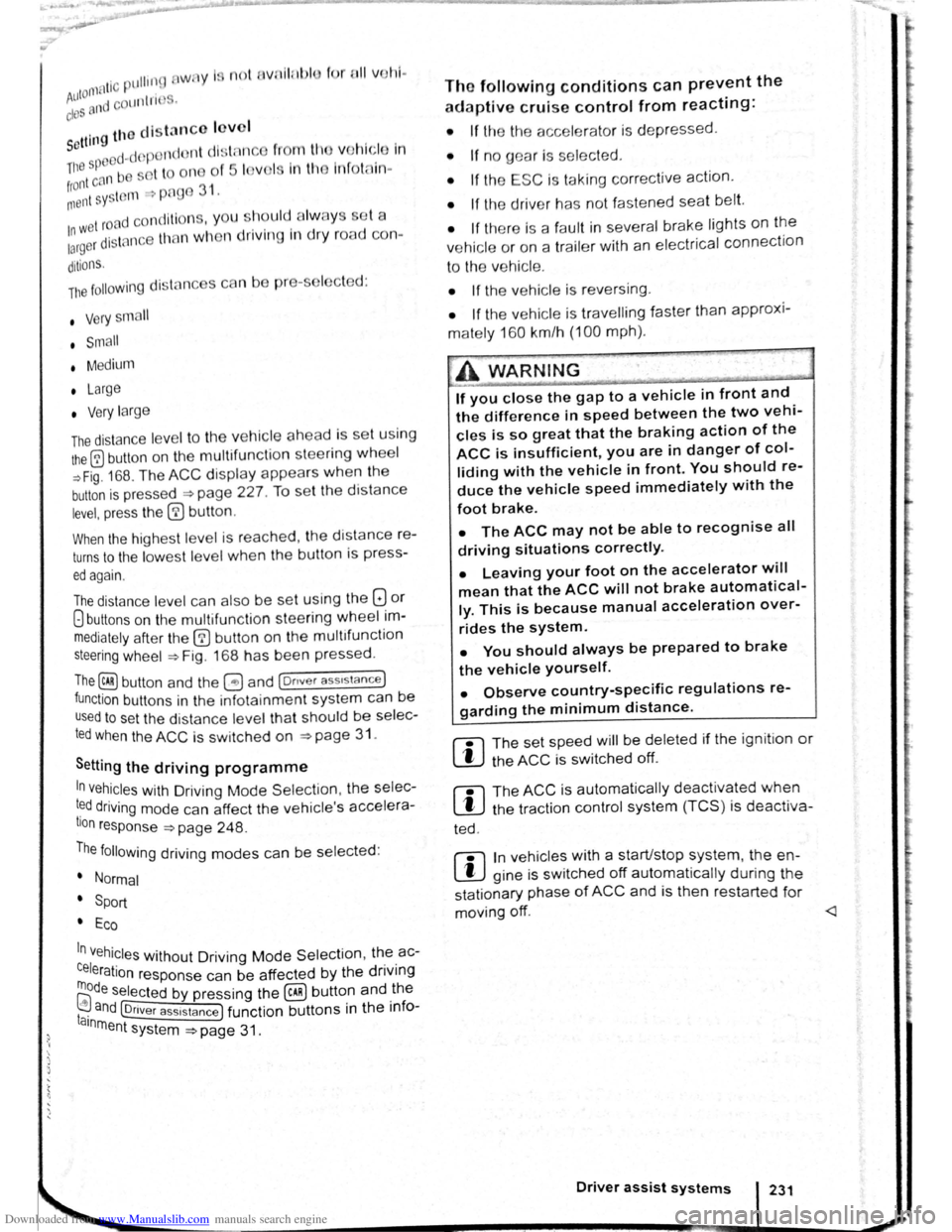
Downloaded from www.Manualslib.com manuals search engine ,,nti pttllinfl W• y I not wnllniJI for tdl vo h l-
fltllOI · and cOtllltJJ(' ciOS ·
. g th o clist::tnco lo vo l sett Ill
P d -d O I nclt nt dl st:1n
lhe s t t o n of 5 I v front can b -
vo hl cl In
lnfot in-
n,ent sy stem ,.-;. Pt g 3 1 .
w et road con d ill n , y u llo uld alw y s s t a
:~rger distn nce lh c n wl 1 n drivl11g In dry road con-
ditions.
lt1e following di sta nc s c n b pre-s I cle d :
• very sm 11
• Small
• Medium
• Large
• V ery large
The dis ta nce le ve l to the ve hi cle ahead is se t u sing
the© button on the multifun ction stee ring wheel
~Fig. 168 . The ACC disp la y appears whe n the
button is pressed ~page 227. To se t th e dis ta nce
level, press the (1) button .
When the hig hes t lev el is reached, the distance re
turns to the low est level when th e butt on is press
ed again.
The distance level can also be set usi ng the Q or
8 buttons on the mult ifun ction stee ring wheel im
mediately after the (1) button on the mult ifunction
steering whee l ~Fig. 168 has been pressed .
The~ button and the G and (Dnver ass1stance )
function buttons in the infotainment system can be
used to set the dista nce level that should be selec
ted when the ACC is sw itched on ~page 31 .
Setting the driving programme
In vehicles with Driving Mode Selection , the selec
t~d driving mode can affect the vehicle 's accelera
tion response ~page 248.
The following driving modes can be selected :
• Normal
• Sport
• Eco
In v h' . e lcles Without Driving Mode Selection , the ac-
Celeration response can be affected by the driving
rnode s I IT.Dl ~a e ected by pressing the ~ butto.n and _ the
I . nd @nver assistance ) function buttons 1n the 1nfoa1nrne t n system ~page 31 .
The following conditions can prevent the
adaptive cruise control from reacting:
• If the the acce le rator is depressed.
• If no g ear is selected .
• If the ESC is taking corre ctive action .
• If the driv er h as no t f astened seat belt.
• If there is a fau lt in seve ral brake lights on the
v e hicle or on a traile r with an electrical
connection
to the vehic le .
• If the vehicle is reve rsing .
• If the vehicle is travelling faster than approxi
mately 160 km/h (100 mph).
A WARNING
If you close the gap to a vehicle in front and
the difference in speed between the two vehi
cles is so great that the braking action of the
ACC is insufficient, you are in danger of col
liding with the vehicle in front. You should re
duce the vehicle speed immediately with the
foot brake.
• The ACC may not be able to recognise all
driving situations correctly.
• Leaving your foot on the accelerator will
mean that the ACC will not brake automatical
ly. This is because manual acceleration over
rides the system.
• You should always be prepared to brake
the vehicle yourself.
• Observe country-specific regulations re
garding the minimum distance.
rn
The set speed will be deleted if the ig nition or
the ACC is switched off.
rn
The ACC is automatically deactivated when
the tract ion control system (T CS ) is deactiva-
ted .
rn
In vehicles with a start/stop system, the e n
g ine is switched off automatical ly during the
stat ionary phase of ACC and is then restarted for
moving off.
Page 118 of 138

Downloaded from www.Manualslib.com manuals search engine Possible radar sensor function impairments
The adaptive cruise control will switch off tempora
rily if th e radar sensor function is impaired , e .g .
due to heavy rain, spray , snow, ice or mud . A cor
responding message will appear in the instrument
clu ster display .
Clean the radar sensors as re
quired .
The adaptive cruise control will automatically be
available again as soon as the radar sensors are
no longer impaired . The message in the instrument
cluster display goes out, and the adaptive cruise
control can be reactivated .
~trong. reflected radiation of the radar signal , e.g.
1n mult1-storey car parks , can impair the function of
the radar sensor .
Towing a trailer
The adaptive cruise control operates with reduced
dynamics when the
vehicle is towing a trailer .
Overheated brakes
If the brak~s. overheat , e .g . following heavy braking
or when
dnv1ng down steep inclines for long peri
ods , the
ada~tive cruise control may be deactiva
ted
t~mpor~nly. A correspond ing message will ap
p e ar
.m the tns~rument cluster display. lt is then not
poss1ble to act1vate the adaptive cruise control.
As soon as the temperature of the brakes has de
creased sufficiently , the adaptive cruise control can
be activated again. The message in the instrument
cluster
display goes out. If the message ACC not
ava i 1 ab 1 e does not go out for a long time, there
is a fault. Proceed to a qualified workshop. Volks
wagen recommends using a Volkswagen dealer
ship for this purpose.
.,. . ..,,
... -,
If the message ACC ready for start ap·
pears
in the instrument cluster display and
th_e vehicle in front moves off, your vehicle
w1ll move off automatically. In some cases
the radar
sensor may be unable to detect ob·
st~cles that are located in the vehicle's path.
Th1s can result in serious injury and acci·
dents.
l
• Always check the road ahead before the
veh~cle pulls away. If necessary, cancel the
pulling away procedure by depressing the
brake
pedal.
~--~--------------------~~
Page 119 of 138

Downloaded from www.Manualslib.com manuals search engine ' )
)
Area monito ring system (Front Assist)
QJl Introduction
This ch a pter contains information on the following
s
ubjects:
warning lamps and displays . . . . . . . . . . . . . . 236
Radar sensor ....... · · . . . . . . . . . . . . . . . . . . 237
Operating the area monitoring system (Front
Assist) .... . .. · · · · · · · · · · · · · · · · · · . . . . . . . . 237
Temporarily switch off the area monitoring
system (Front Assist) in the following
s it u
ations . . . . . . . . . . . . . . . . . . . . . . . . . . . . . . 238
System limits . . . . . . . . . . . . . . . . . . . . . . . . . . . 238
C i
ty emergency brake function . . . . . . . . . . . . 239
The area monitoring system (Front Assist) helps to
avoid rear-end collisions.
lt uses a radar sensor to monitor traffic situations
up to a distance of approximately 120 metres in
front of the vehicle within a speed range of approx
i
mately 5 km/h (3 mph) to 210 km/h (130 mph) .
The area monitoring system (Front Assist) can
warn the driver about imminent collisions, pre
pare the vehicle for emergency braking in case
of danger, assist with braking, and initiate auto
matic braking.
Additional
information and warnings:
• Exterior views ~page 6
• Volkswagen information system ~ page 26
• lnfotainment system ~page 31
' Cruise Control System (CCS ) ~page 218
'
Speed limiter ~page 222
' Accessories , modifications , repairs and renewal
o f
Parts ~page 320
Distance warning
If the system detects danger from driving too close
to.the vehicle in front , the system can warn the
~nver by showing a corresponding message in the
~nstrument cluster display ~page 236. The warn
Ing Period varies according to the traffic situation
a
nd the driver's response . Front Assist is not a
sub t · · s ltue for the full concentration of the dnver .
Advance warning
h lfth e system detects a potential collision with a veICI · e .e .1n front, the system can warn the driver by 1111tt1ng an acoustic warning and showing a corre-spond· · PI lng message in the instrument clus~er diS-
ay ~Page 236 . The warning period vanes ac- carding
to the
traffic situation and the driver's re
sponse . Front Assist is not a substitue for the
full
concentration of the driver .
At the
same time it prepares the vehicle for possi
ble emergency braking ~ ~.
Urgent warning
If the driver fails to respond to the advance warn
ing, the system can initiate a quick jolt of the brake
in order to draw the driver's attention to the
in
creasing danger of a collision.
Automatic braking
If the driver also fails to react to the urgent warn
ing, the system can slow the vehicle down auto
matically by gradually increasing the braking force.
The system can help to reduce the consequences
of an accident by reducing the speed at which a
potential collision might take place .
Brake assistance
If Front Assist detects that the driver is not braking
sufficiently when there is a risk
of collision , the sys
tem can increase the braking force and thereby
help to prevent a collision . Brake assistance works
only
for as long as the brake pedal is pressed
hard.
The intelligent technology used in Front As
sist cannot overcome the laws of physics.
The driver is always responsible for braking
in time. If Front Assist issues a warning, im
mediately apply the foot brake to slow the ve
hicle down or avoid the obstacle, depending
on the traffic situation.
• Adapt your speed and distance from the
vehicles ahead to suit visibility, weather, road
and traffic conditions.
• Front Assist cannot prevent accidents and
serious injuries on its own.
• Front Assist can issue unnecessary warn
ings and carry out unwanted braking inter
ventions in certain complex driving situa
tions, e.g . at traffic islands.
~----------------------------_j~
Driver assist systems 235
-